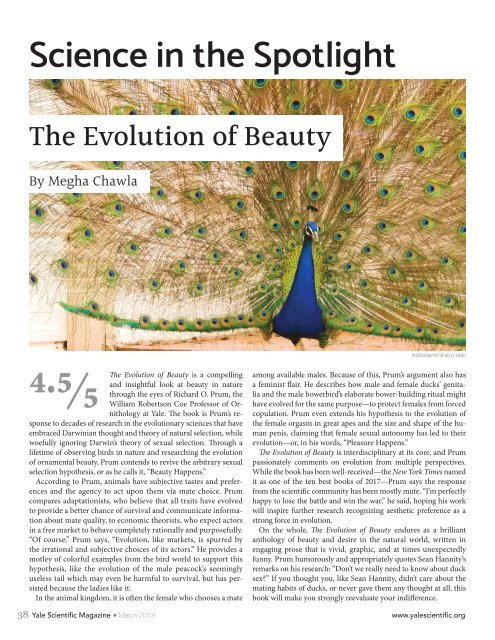YSM Issue 91.1
You also want an ePaper? Increase the reach of your titles
YUMPU automatically turns print PDFs into web optimized ePapers that Google loves.
Science in the Spotlight<br />
The Evolution of Beauty<br />
By Megha Chawla<br />
PHOTOGRAPHY BY KELLY ZHOU<br />
4.5/5<br />
The Evolution of Beauty is a compelling<br />
and insightful look at beauty in nature<br />
through the eyes of Richard O. Prum, the<br />
William Robertson Coe Professor of Ornithology<br />
at Yale. The book is Prum’s response<br />
to decades of research in the evolutionary sciences that have<br />
embraced Darwinian thought and theory of natural selection, while<br />
woefully ignoring Darwin’s theory of sexual selection. Through a<br />
lifetime of observing birds in nature and researching the evolution<br />
of ornamental beauty, Prum contends to revive the arbitrary sexual<br />
selection hypothesis, or as he calls it, “Beauty Happens.”<br />
According to Prum, animals have subjective tastes and preferences<br />
and the agency to act upon them via mate choice. Prum<br />
compares adaptationists, who believe that all traits have evolved<br />
to provide a better chance of survival and communicate information<br />
about mate quality, to economic theorists, who expect actors<br />
in a free market to behave completely rationally and purposefully.<br />
“Of course,” Prum says, “Evolution, like markets, is spurred by<br />
the irrational and subjective choices of its actors.” He provides a<br />
motley of colorful examples from the bird world to support this<br />
hypothesis, like the evolution of the male peacock’s seemingly<br />
useless tail which may even be harmful to survival, but has persisted<br />
because the ladies like it.<br />
In the animal kingdom, it is often the female who chooses a mate<br />
among available males. Because of this, Prum’s argument also has<br />
a feminist flair. He describes how male and female ducks’ genitalia<br />
and the male bowerbird’s elaborate bower-building ritual might<br />
have evolved for the same purpose—to protect females from forced<br />
copulation. Prum even extends his hypothesis to the evolution of<br />
the female orgasm in great apes and the size and shape of the human<br />
penis, claiming that female sexual autonomy has led to their<br />
evolution—or, in his words, “Pleasure Happens.”<br />
The Evolution of Beauty is interdisciplinary at its core, and Prum<br />
passionately comments on evolution from multiple perspectives.<br />
While the book has been well-received—the New York Times named<br />
it as one of the ten best books of 2017—Prum says the response<br />
from the scientific community has been mostly mute. “I’m perfectly<br />
happy to lose the battle and win the war,” he said, hoping his work<br />
will inspire further research recognizing aesthetic preference as a<br />
strong force in evolution.<br />
On the whole, The Evolution of Beauty endures as a brilliant<br />
anthology of beauty and desire in the natural world, written in<br />
engaging prose that is vivid, graphic, and at times unexpectedly<br />
funny. Prum humorously and appropriately quotes Sean Hannity’s<br />
remarks on his research: “Don’t we really need to know about duck<br />
sex?” If you thought you, like Sean Hannity, didn’t care about the<br />
mating habits of ducks, or never gave them any thought at all, this<br />
book will make you strongly reevaluate your indifference.<br />
38 Yale Scientific Magazine March 2018 www.yalescientific.org


















